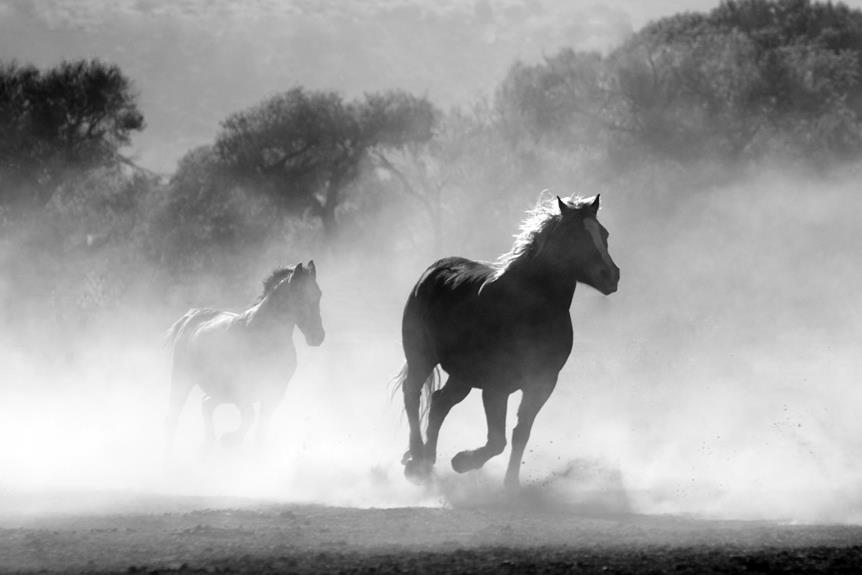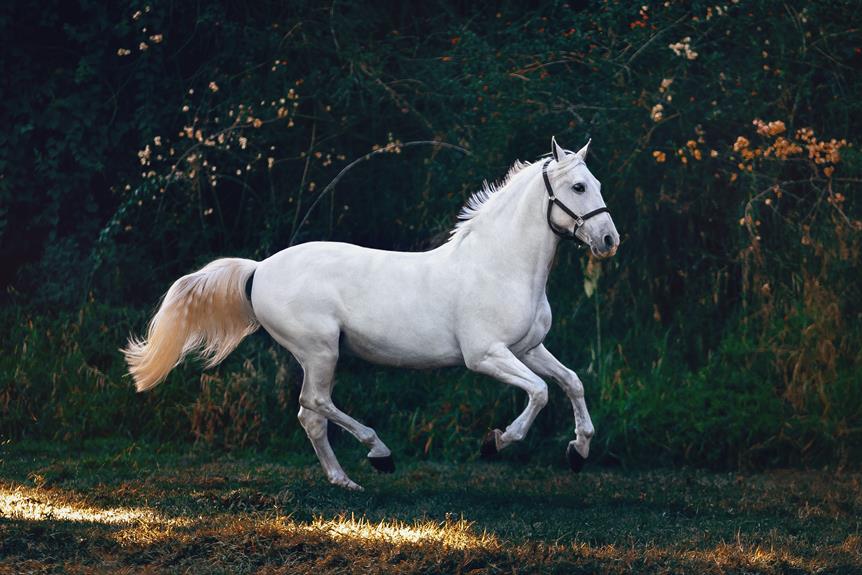Have you ever wondered what horse chestnuts are and why they are called by such an intriguing name?
Horse chestnuts, though not actually related to the edible chestnuts, are peculiar growths found on the legs of horses. But what exactly are they? And are they as harmless as they seem?
In this discussion, we will explore the physical characteristics, distribution, and uses of horse chestnuts, as well as uncover some interesting facts about these enigmatic formations.
So, saddle up and let's embark on a journey to unravel the mysteries of horse chestnuts together.
Key Takeaways
- Horse chestnuts are tall trees with distinctive leaves and pinky-grey bark that are native to the Balkan Peninsula in Southeast Europe.
- They have been introduced to various parts of the world, including the United Kingdom, where they can commonly be found in parks, gardens, streets, and village greens.
- Horse chestnuts provide a rich source of nectar and pollen for insects, and their flowers have 4-5 fringed petals that are primarily white with a pink flush at the base.
- Horse chestnut seed extract has various uses and benefits, including treating chronic venous insufficiency, potentially improving male infertility, and having anti-inflammatory and antioxidant properties. However, it is important to consult with a healthcare provider before use, especially if taking blood clotting medications.
Physical Characteristics of Horse Chestnuts
The physical characteristics of horse chestnuts include a tall stature, distinctive leaves, and flowers that provide a rich source of nectar and pollen for insects.
The horse chestnut tree can reach heights of up to 40 meters, towering over its surroundings. Its pinky-grey bark, which darkens and becomes scaly as the tree ages, adds to its unique appearance.
The leaves of the horse chestnut tree are easily recognizable, with 5-7 pointed, toothed leaflets. In the autumn, these leaves transform into vibrant shades of yellow and red, creating a stunning display of colors.
During the month of May, horse chestnut trees produce beautiful flowers. These flowers have 4-5 fringed petals and are primarily white, with a pink flush at the base. Not only are these flowers visually appealing, but they also serve as a valuable source of nectar and pollen for insects. Bees, butterflies, and other pollinators are attracted to the horse chestnut flowers, contributing to the ecosystem's biodiversity.
While horse chestnuts are known for their physical characteristics, they also possess medicinal properties. Horse chestnut seed extracts have been used for centuries to treat various conditions, particularly chronic venous insufficiency. This condition occurs when the veins in the legs are unable to efficiently return blood to the heart.
Studies have shown that horse chestnut seed extract can help alleviate symptoms such as leg pain, swelling, and itching. Its active compounds have been found to strengthen veins and improve blood flow, making it a popular choice for those seeking relief from chronic venous issues.
Distribution and Habitat of Horse Chestnuts
As we shift our focus to the distribution and habitat of horse chestnuts, let's explore where these trees can be found and the environments they thrive in.
Horse chestnuts, scientifically known as Aesculus hippocastanum, are native to the Balkan Peninsula in Southeast Europe. However, they've been introduced to various parts of the world, including the United Kingdom, where they were brought in the late 16th century. In the UK, horse chestnuts are commonly found in parks, gardens, streets, and village greens. They're often planted for their ornamental value and provide shade and beauty to these urban areas.
Horse chestnuts aren't typically found in woodlands. They prefer open, sunny locations with well-drained soil. These trees thrive in temperate climates and can tolerate a wide range of soil conditions, from sandy to clayey. They've a preference for slightly acidic to neutral soil.
Horse chestnuts are known for their large, showy flowers and distinctive palmate leaves. Their towering stature and attractive foliage make them a popular choice for landscaping in urban areas.
Uses and Benefits of Horse Chestnuts
To explore the uses and benefits of horse chestnuts, let's delve into their potential medicinal properties and how they can be beneficial for various health conditions.
- Horse chestnut seed extract, also known as Escin, has been widely studied for its potential in treating chronic venous insufficiency (CVI). CVI is a condition where the veins in the legs have difficulty returning blood to the heart. Horse chestnut seed extract has shown promising results in improving symptoms of CVI, such as leg pain, swelling, and itching.
- In addition to CVI, horse chestnut seed extract has also been researched for its effects on male infertility. Studies have shown that standardized horse chestnut seed extract can improve sperm quality in male patients with varicocele-associated infertility. Varicocele is a condition where the veins inside the scrotum become enlarged, affecting sperm production and quality.
- Furthermore, horse chestnut seed extract has been found to have anti-inflammatory and antioxidant properties, which may contribute to its potential health benefits. These properties make it a possible natural remedy for other conditions like irritable bowel syndrome.
It's important to note that while horse chestnut seed extract has shown promise in research, it's essential to consult with a healthcare provider before using it, especially if you're taking medications that slow blood clotting.
Interesting Facts About Horse Chestnuts
You'll be fascinated to learn some intriguing facts about horse chestnuts, a unique tree native to southeastern Europe with a rich history and diverse uses.
Horse chestnuts, despite their name, aren't related to the edible chestnuts that you enjoy. They shouldn't be confused with each other.
The horse chestnut tree, originating from southeastern Europe, was introduced to the UK in the late 16th century.
Horse chestnut seed extract, derived from the fruits of the tree, is used in various medicinal applications. It's known to treat chronic venous insufficiency, irritable bowel syndrome, and male infertility. However, it's important to note that raw horse chestnut parts and seeds are toxic and unsafe for consumption. They shouldn't be eaten.
On the other hand, standardized extracts made from horse chestnuts are considered safe for short-term use.
Another interesting fact is that horse chestnuts have been used for centuries to influence the coat color of horses.
While these facts are intriguing, it's essential to consult reliable sources such as Natural Medicines for accurate information about horse chestnuts and their uses.
Conservation Efforts for Horse Chestnuts
Conservation efforts for horse chestnuts are crucial to ensure the survival of these magnificent trees. To protect and preserve horse chestnuts, various measures are being implemented:
- Environmental Protection: Dedicated organizations are working to safeguard the natural habitats of horse chestnuts, ensuring they have the necessary resources to thrive. This includes protecting their native forests and woodlands from deforestation and urbanization.
- Disease Management: Due to the threat of diseases like chestnut blight and bleeding canker, efforts are being made to identify and manage these ailments. Scientists are conducting research, implementing preventive measures, and developing treatments to combat these diseases and protect the horse chestnut population.
- Education and Awareness: Raising public awareness about the importance of horse chestnuts is vital for their conservation. Educational programs, campaigns, and outreach initiatives are being carried out to inform people about the significance of these trees in the ecosystem and the need to preserve them.
By implementing these conservation efforts, we can help ensure the long-term survival of horse chestnuts and the many benefits they provide to our environment and biodiversity.
Keywords: horse chestnuts, conservation efforts, environmental protection, disease management, education and awareness.
Frequently Asked Questions
What Is the Purpose of Chestnuts on Horses?
The purpose of chestnuts on horses is still uncertain. They differ in size and shape, but their role in horse identification remains unclear. Horse owners groom them regularly, as they can cause sensitivity.
Should You Remove Horse Chestnuts?
You should consider removing horse chestnuts if they are causing discomfort for your horse. Consult a farrier to safely remove them.
What Does Horse Chestnut Do to Your Body?
Horse chestnuts can potentially cause side effects, but they have been used in traditional medicine for various conditions. They may improve blood circulation, reduce leg swelling, and have anti-inflammatory properties. Horse chestnut extract may be effective for varicose veins. It's important to take safety precautions when using horse chestnut products.
What Are Horse Chestnuts Called in America?
In America, horse chestnuts are commonly called 'conkers.' They come from the horse chestnut tree, which was introduced to the UK in the late 16th century. These trees have various traditional uses, health benefits, and culinary uses.
Conclusion
So, now you know that horse chestnuts are small, round growths found on the legs of horses. They're harmless and don't cause any discomfort to the horse. Chestnuts are made of keratin and feel oily and scaly to the touch. They're commonly found on the inside of the hind legs or above the knee on the front legs.
Remember, they're often referred to as 'Night Eyes' due to a belief that they give horses the ability to see in the dark.



0 Comments